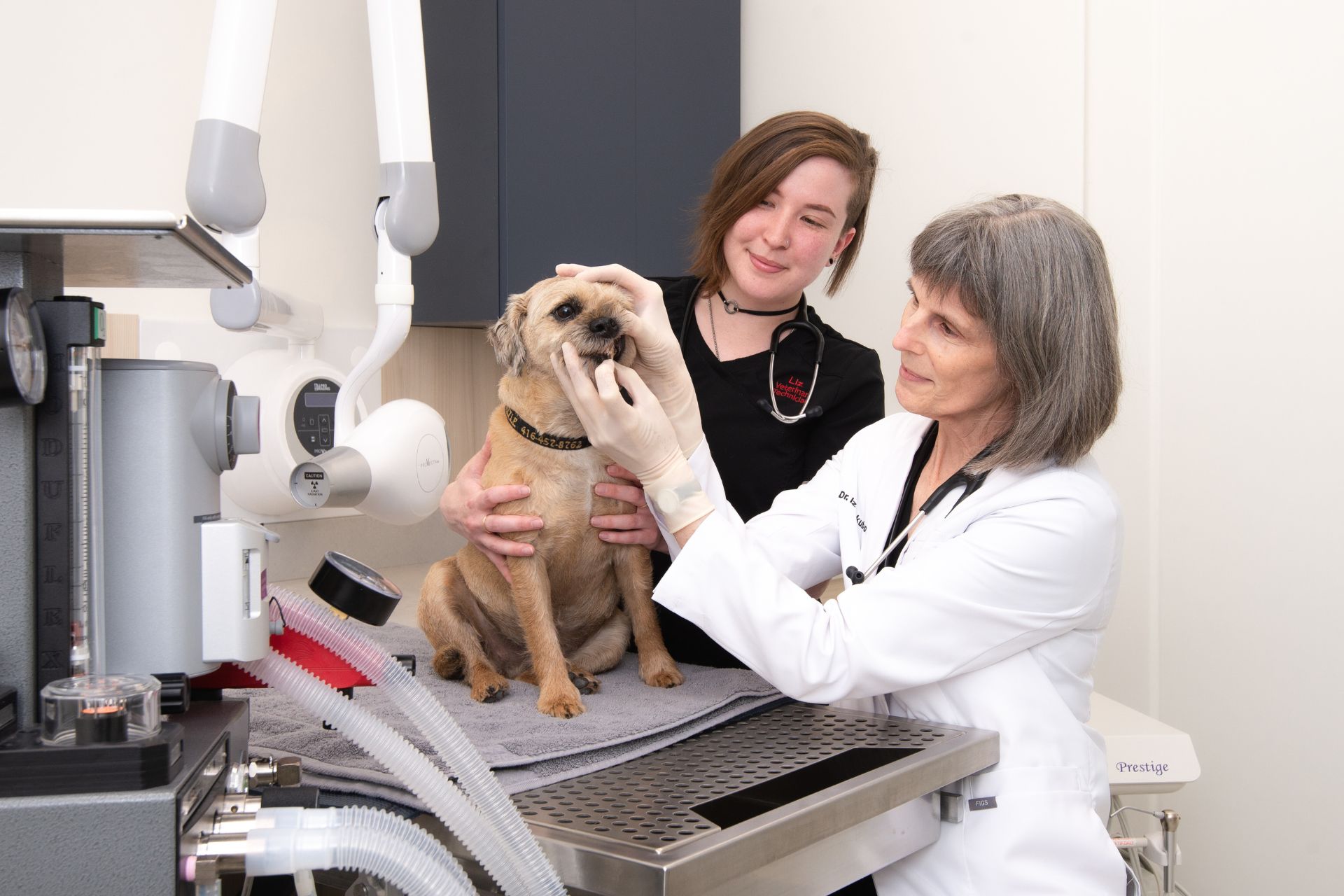Service
Dentistry
Josh M.

Periodontal disease (disease of the tissues supporting teeth) is the most common disease of dogs and cats. It’s caused by a buildup of plaque (a sticky film containing bacteria) and tartar (plaque that’s hardened and cemented itself to a tooth) that irritate gums and cause inflammation (gingivitis). Left unattended, tooth roots and their surrounding structures become infected and inflamed and begin to decay and loosen.
Signs of periodontal disease include bad breath, loose teeth, sensitivity around the face, excessive drooling, bleeding from the mouth, dropping food, and weight loss.
Prevention of periodontal disease can be achieved with daily tooth brushing as well as the use of dental diets and/or dental chews and other products designed to help clean teeth. Despite your best efforts, your pet may still develop enough plaque, tartar, &/or gum inflammation to warrant a professional cleaning under a general anesthetic before matters worsen. At routine (or other) visits, your vet will assess your pet’s oral health to let you know when treatment is indicated.
Treatment of moderate to severe periodontal disease involves placing a patient under general. anesthesia, cleaning each tooth surface, taking dental x-rays to evaluate oral health below the gumline, probing for problems below the gumline (cavities, root exposure and so on), and if necessary, extracting teeth if there’s sufficient damage from disease to warrant it.
Why does my pet need to be under general anesthesia for a dental procedure?
Veterinary dentistry is very similar to human dentistry. Both require patients to keep still for dental x-rays and to endure high-pitched, high-speed instruments that scrape and polish teeth and clean under the gumline – procedures that no cat or dog will tolerate while awake. (True for some people too.) General anesthesia allows our patients to sleep through the procedure while we do whatever is warranted (including removing any damaged teeth) safely, properly, and without causing your pet undue distress.
We do everything we can to ensure your pet’s safety: a full physical exam prior to anesthesia, a review of blood work and medical history, anesthetic protocols tailored to your pet, and intravenous fluids and close monitoring during and after the procedure.
Are x-rays of my pet’s teeth really necessary?
Dental x-rays (radiographs) are the only way we can evaluate what’s going on below the gumline. They allow us to:
-
- see if there’s enough bone loss and damage to a root to warrant removing a tooth
- identify any risks associated with an extraction
- determine whether a missing tooth is truly missing or simply failed to erupt; the latter can lead to the development of a cyst (fluid-filled sac) around the tooth that can damage jawbone if left unattended
- confirm that an extraction was completed successfully (e.g., no root tips left behind)
- We have two types of dental imaging systems – Digital radiography (DR) and Computer radiography (CR) – to give us the flexibility to choose the one most suited to your pet whether that’s a small cat or a Great Dane. Compared to traditional film x-rays, both DR and CR require significantly less radiation and produce a higher quality image. DR uses smaller plates on which to project an image and is suited to small-to-medium sized pets. CR provides larger plates and is more suited to large-to-giant-sized dogs. (With CR, we don’t need as many plates to get a complete picture, which means less radiation and shorter anesthetic time for those breeds.)
What about those places that offer anesthesia-free cleanings?
Ontario law prohibits anesthesia-free dentistry by non-veterinarians because it’s a disservice to the pets receiving them. Lay people offering these cleanings get around the law by offering “cosmetic” cleanings. In other words, just a superficial scraping of teeth. Cosmetic cleanings leave owners with a false impression about their pet’s oral health, and they set pets up for failure (dental disease that progresses below the gumline and leads to oral discomfort and tooth loss).
“I couldn’t complement the team at Southeast Oakville Veterinary Hospital enough. They took exceptional care of my highly anxious and nervous dog, Rosie, and she felt at home the entire time.
We took Rosie in for a dental exam and dental cleaning and we had an amazing experience with Dr. Iz and Dr. Derek – they were professional, caring and generous with their time and support. Rosie’s teeth look great and I would recommend all services offered by the clinic to anyone.”




